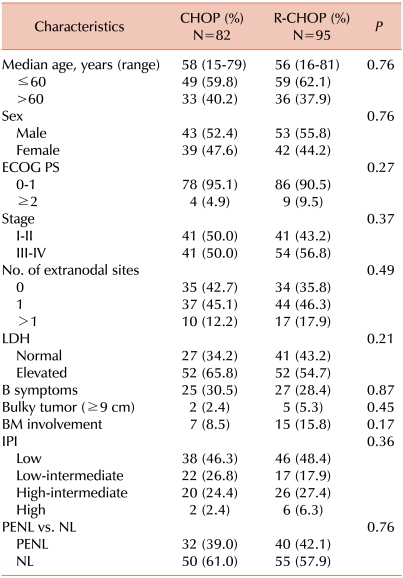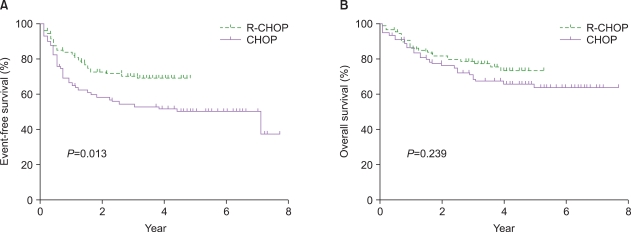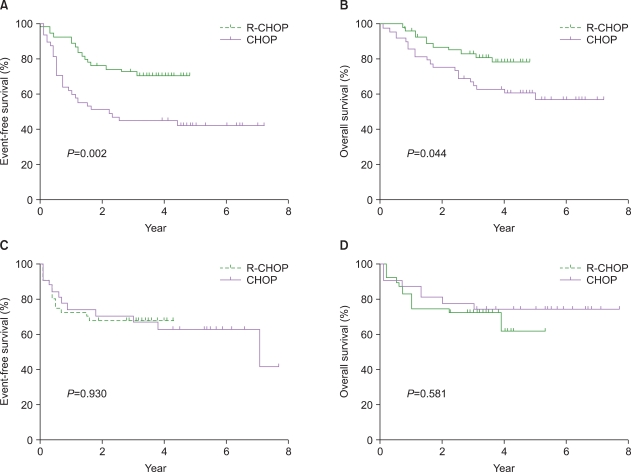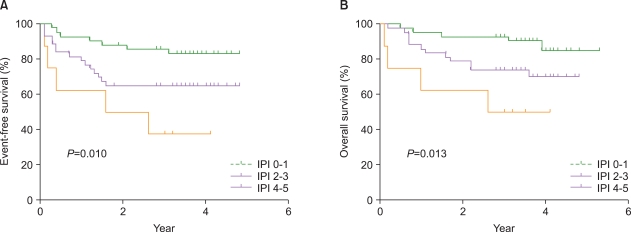1. Gatter KC, Warnke RA. Jaffe ES, Harris NL, Stein H, editors. Diffuse large B-cell lymphoma. World Health Organization Classification of Tumors: Pathology and genetics of tumours of haematopoietic and lymphoid tissues. 2001. 3rd ed. Lyon, France: IARC Press;p. 171–174.
2. Coiffier B. Diffuse large cell lymphoma. Curr Opin Oncol. 2001; 13:325–334. PMID:
11555708.

3. Gordon LI, Harrington D, Andersen J, et al. Comparison of a second-generation combination chemotherapeutic regimen (m-BACOD) with a standard regimen (CHOP) for advanced diffuse non-Hodgkin's lymphoma. N Engl J Med. 1992; 327:1342–1349. PMID:
1383819.

4. Fisher RI, Gaynor ER, Dahlberg S, et al. Comparison of a standard regimen (CHOP) with three intensive chemotherapy regimens for advanced non-Hodgkin's lymphoma. N Engl J Med. 1993; 328:1002–1006. PMID:
7680764.

5. Coiffier B, Haioun C, Ketterer N, et al. Rituximab (anti-CD20 monoclonal antibody) for the treatment of patients with relapsing or refractory aggressive lymphoma: a multicenter phase II study. Blood. 1998; 92:1927–1932. PMID:
9731049.
6. Vose JM, Link BK, Grossbard ML, et al. Phase II study of rituximab in combination with CHOP chemotherapy in patients with previously untreated, aggressive non-Hodgkin's lymphoma. J Clin Oncol. 2001; 19:389–397. PMID:
11208830.

7. Coiffier B, Lepage E, Briere J, et al. CHOP chemotherapy plus rituximab compared with CHOP alone in elderly patients with diffuse large-B-cell lymphoma. N Engl J Med. 2002; 346:235–242. PMID:
11807147.

8. Feugier P, VanF Hoof A, Sebban C, et al. Long-term results of the R-CHOP study in the treatment of elderly patients with diffuse large B-cell lymphoma: a study by the Groupe dEtudes des Lymphomes de lAdulte. J Clin Oncol. 2005; 23:4117–4126. PMID:
15867204.
9. Sehn LH, Donaldson J, Chhanabhai M, et al. Introduction of combined CHOP plus rituximab therapy dramatically improved outcome of diffuse large B-cell lymphoma in British Columbia. J Clin Oncol. 2005; 23:5027–5033. PMID:
15955905.

10. Pfreundschuh M, Trümper L, Osterborg A, et al. CHOP-like chemotherapy plus rituximab versus CHOP-like chemotherapy alone in young patients with good-prognosis diffuse large-B-cell lymphoma: a randomised controlled trial by the MabThera International Trial (MInT) Group. Lancet Oncol. 2006; 7:379–391. PMID:
16648042.
11. A predictive model for aggressive non-Hodgkin's lymphoma. The Iinternational Non-Hodgkin's Llymphoma prognostic factors project. N Engl J Med. 1993; 329:987–994. PMID:
8141877.
12. Sehn LH, Berry B, Chhanabhai M, et al. The revised International Prognostic Index (R-IPI) is a better predictor ofr outcome than the standard IPI for patients with diffuse large B-cell lymphoma DLBCL treated with R-CHOP. Blood. 2007; 109:1857–1861. PMID:
17105812.
13. Mounier N, Briere J, Gisselbrecht C, et al. Rituximab plus CHOP (R-CHOP) overcomes bcl-2-associated resistance to chemotherapy in elderly patients with diffuse large B-cell lymphoma (DLBCL). Blood. 2003; 101:4279–4284. PMID:
12576316.

14. Winter JN, Weller EA, Horning SJ, et al. Prognostic significance of Bcl-6 protein expression in DLBCL treated with CHOP or R-CHOP: a prospective correlative study. Blood. 2006; 107:4207–4213. PMID:
16449523.

15. Zucca E, Roggero E, Bertoni F, Cavalli F. Primary extranodal non-Hodgkin's lymphomas. Part 1: Gastrointestinal, cutaneous and genitourinary lymphomas. Ann Oncol. 1997; 8:727–737. PMID:
9332679.

16. Newton R, Ferlay J, Beral V, et al. The epidemiology of non-Hodgkin's lymphoma: cComparison of nodal and extra- nodal sites. Int J Cancer. 1997; 72:923–930. PMID:
9378552.
17. Otter R, Gerrits WB, vd Sandt MM, Hermans J, Willemze R. Primary extranodal and nodal non-Hodgkin's lymphoma. A survey of a population-based registry. Eur J Cancer Clin Oncol. 1989; 25:1203–1210. PMID:
2767109.
18. Shih LY, Liang DC. Non-Hodgkin's lymphomas in Asia. Hematol Oncol Clin North Am. 1991; 5:983–1001. PMID:
1938764.

19. Aozasa K, Tsujimoto M, Sakurai M, et al. Non-Hodgkin's lymphomas in Osaka, Japan. Eur J Cancer Clin Oncol. 1985; 21:487–492. PMID:
4007017.

20. Kim CW, Kim I, Ko YH, et al. Clinicopathologic and immunophenotypic study of non-Hodgkin's lymphoma in Korea. Lymphoreticular Study Group of the Korean Society of Pathologists. J Korean Med Sci. 1992; 7:193–198. PMID:
1285918.
21. Kramer MH, Hermans J, Parker J, et al. Clinical significance of bcl2 and p53 protein expression in diffuse large B-cell lymphoma: a population-based study. J Clin Oncol. 1996; 14:2131–2138. PMID:
8683246.

22. Houldsworth J, Mathew S, Rao PH, et al. REL proto-oncogene is frequently amplified in extranodal diffuse large cell lymphoma. Blood. 1996; 87:25–29. PMID:
8547649.

23. Grønbaek K, Straten PT, Ralfkiaer E, et al. Somatic Fas mutations in non-Hodgkin's lymphoma: association with extranodal disease and autoimmunity. Blood. 1998; 92:3018–3024. PMID:
9787134.
24. Rao PH, Houldsworth J, Dyomina K, et al. Chromosomal and gene amplification in diffuse large B-cell lymphoma. Blood. 1998; 92:234–240. PMID:
9639522.

25. Cheson BD, Pfistner B, Juweid ME, et al. Revised response criteria for malignant lymphoma. J Clin Oncol. 2007; 25:579–586. PMID:
17242396.
26. Park YH, Lee JJ, Ryue MH, et al. Improved therapeutic outcomes of DLBCL after introduction of rituximab in Korean patients. Ann Hematol. 2006; 85:257–262. PMID:
16416337.

27. Kramer MH, Hermans J, Parker J, et al. Clinical significance of bcl2 and p53 protein expression in diffuse large B-cell lymphoma: a population-based study. J Clin Oncol. 1996; 14:2131–2138. PMID:
8683246.

28. Lopez-Guillermo A, Colomo L, Jimenez M, et al. Diffuse large B-cell lymphoma: clinical and biological characterization and outcome according to the nodal or extranodal primary origin. J Clin Oncol. 2005; 23:2797–2804. PMID:
15728226.







 PDF
PDF ePub
ePub Citation
Citation Print
Print






 XML Download
XML Download